In 1304, Stirling Castle was put under siege by King Edward I of England.
In this article you can find out:
- What a castle siege is
- How people prepared for a siege
- Different types of siege weapons
- What the Scottish Wars of Independence were
This resource is suitable for Castles topics for P2, P3, P4, P5, P6 and P7 (First and Second Level Curriculum for Excellence).
Watch the film below to learn how just 30 Scottish defenders were able to hold the castle for months, even against Edward's mighty army.
Find out what life was like in a castle under siege.
What is a siege?
A siege is when an enemy surrounds a town, castle or other building so no one can escape and no food can get in.
It was very important for the people inside the castle to be prepared. They needed supplies of food and water to live on.
Getting fresh food was difficult so they needed to find ways to preserve food by drying, salting and storing it. For a safe water supply, castles needed their own well.
Preparing for a siege
Look at the photos below to find out a bit more about how defenders prepared for a castle siege.

Image caption, Well
During a siege, attackers could poison the water coming into a castle and the people inside would have to surrender. Digging a well inside the castle meant there was a safe supply of water that enemies couldn't get at. This photo shows the well at Dunstaffnage Castle near Oban.
Image caption, Storing
Food was usually stored underneath the castle or on the ground floor of the tower keep. Keeping food underground meant it was harder for thieves or enemies to get to it. In this photo, you can see the underground storage at Dirleton Castle in East Lothian.
Image caption, Salting
Salt was used to dry out fish or meat so that it wouldn't go off. Covering meat or fish in salt drew the moisture out and killed bacteria. The problem was everything tasted very salty - yuck!
Image caption, Drying
Most meats, fruits and grains (like rye and wheat) could be preserved through drying. In Scotland it was often too cold to dry food outside, so ovens were often used instead. This photo shows an oven at Tolquhon Castle in Aberdeenshire where food could be dried and bread could be baked.
1 of 4
Siege weapons
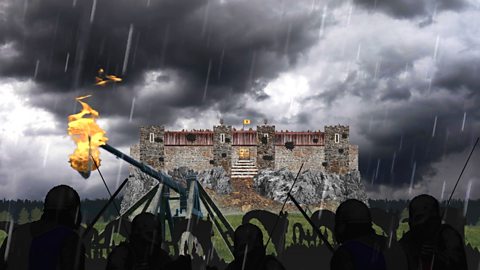
Attackers surrounding a castle in a siege could use different kinds of siege engines to attack the castle and make it weaker.
Some medievalThe medieval times or Middle Ages describe a period of time in history. The medieval period lasted from around the year 500 AD to 1500 AD siege weapons included:
- trebuchets
- mangonels
- cannons
- battering rams
- siege towers

What were the Scottish Wars of Independence?
The Wars of Independence were a series of battles fought between Scotland and England from 1296 to 1328.
England wanted to take control of Scotland's castles to show off how powerful they were.
Scotland had to defend their castles from the English army.
There were many castle sieges during the Scottish Wars of Independence.
Find out more about the Wars of Independence with 2nd level Bitesize.

Stirling Castle
In the video at the top of the page, we learned about a siege at Stirling Castle in 1304.
Let's find out more about the history of Stirling Castle and why it is an important part of Scottish history.
Springholm Primary find out more about Stirling Castle, from the Lion’s Den to the skeletons found buried underneath the chapel.
Test your knowledge

Draw and label a trebuchet
Can you draw a picture of a trebuchet and label its different parts? Use this drawing of a medieval trebuchet to help you.
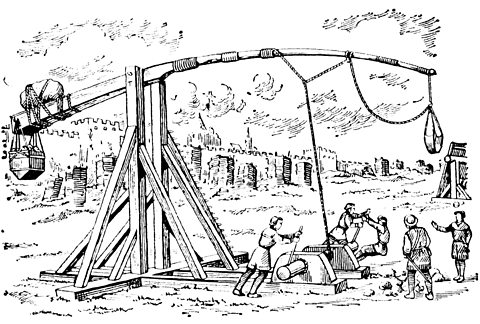
Here are the different parts of a trebuchet you need to label:
- frame or base - The main body of the trebuchet which keeps everything in place.
- beam or throwing arm - The long arm of the catapult, it has the sling on one side and a counterweight on the other.
- sling or pouch - Where the 'payload' or 'projectile' would be placed.
- payload or projectile - The object that the attackers would hurl at the castle, like a heavy rock or fireball!
- pivot - Where the beam and the trebuchet frame meet.
- counterweight - A heavy object that weighs one side of the beam down.
More on Castles
Find out more by working through a topic
- count8 of 16
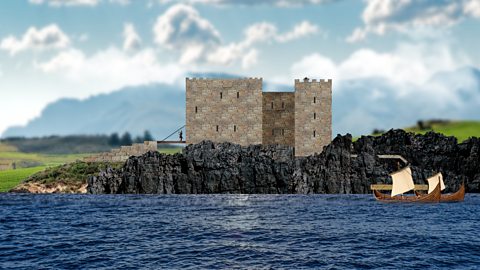
- count9 of 16
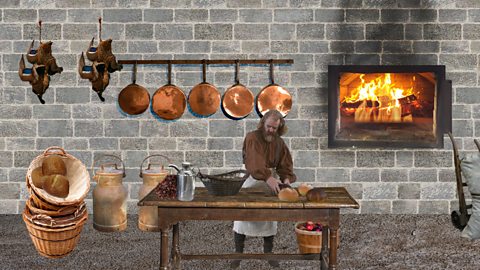
- count10 of 16
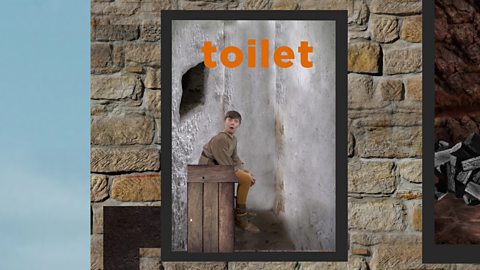
- count11 of 16
